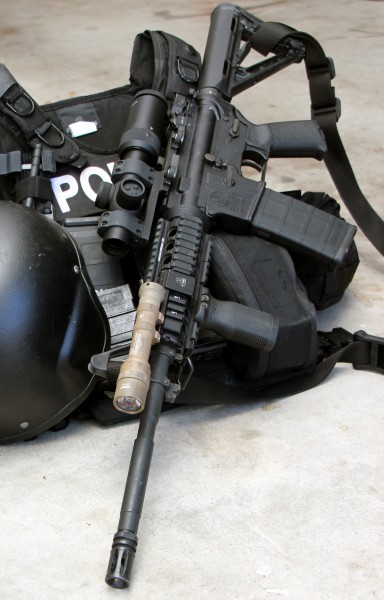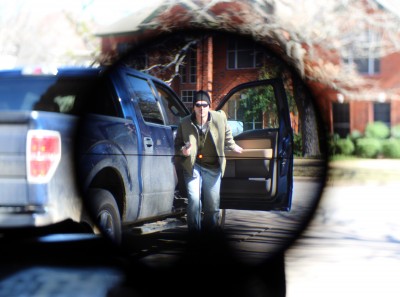
SR4C mounted on issued patrol rifle with issued plate carrier and ballistic helmet. The optic’s eye box was large enough on 1x to accommodate the extra personal protective equipment without issue.
While longer range performance is certainly beneficial, close range engagements are the bread and butter of the patrol rifle optic. The RDO has become so prolific due to its speed at getting on target at these short distances where an officer is the most exposed. Long range performance is moot if the patrol optic cannot mimic the RDO where it matters most. I put the SR4C head to head against my issued rifle setup: a S&W M&P 15 with 16” M4 profile barrel and Aimpoint M2. Using the M&P15 I ran each optic several times through the Combat Shooting and Tactics (CSAT) close range rifle instructor standards developed by MSgt Paul Howe. The standards are representative of the rifle skills that MSgt Howe found most useful during his time in US Army Special Forces SFOD-D, and those are what he teaches to military, police, and civilian students today. While the standards are normally pass/fail, I recorded multiple runs of each standard with each optic on the M&P15 using a shot timer and averaged the results to see if either optic had a speed advantage. Each standard was performed at the 7 yard line against USPSA targets requiring hits to either the A-zone or the head box depending on the drill. The standards I shot included: 1 shot on one target, 2 shots on one target, 2 shots to the body and 1 shot to the head, 5 shots to the body and 1 shot to the head, 2 shots each on two targets. The results were remarkably consistent with the total cumulative difference of less than 3% between the times of each optic. At this range each optic simply superimposed a clean 4 MOA dot on the target when I snapped the rifle up, and both the Aimpoint and SR4C looked and performed identically.

Reticle view on 1x at 10 yards. With its 4MOA red dot, the SR4C demonstrated RDO-type performance on 1x in all lighting conditions on both static and moving targets.
Pushing back to 50 yards, I setup three 8 inch wide mini-silhouette steel targets for a 5-3 drill: 5 hits total on 3 targets from the standing position. Firing one hit on each target moving one direction then reversing direction to re-engage the first two targets allows the shooter to practice target transitions in both directions, and the 8 inch targets require perfect trigger control. The standing position requires the shooter to perfectly time the trigger to break when the dot is on target during the shooter’s natural body movement. This can prove difficult with a long and heavy mil-spec trigger since the dot can move significantly from natural body movement during the trigger travel even with a perfect pull. While the Aimpoint required some extra time to ensure the dot was perfectly centered on the target, dialing in a little magnification on the SR4C allowed me to see exactly where on the target the dot was located and how much room for error I had while still attaining a hit. Since I did not have to spend extra time getting a perfectly centered sight picture, the SR4C was about 25% faster than the Aimpoint at this range. Moving back further to 90 yards, I setup a barricade drill requiring short movement to a window, engaging an 8 inch mini-silhouette, and moving to a second window to engage another 8 inch mini-silhouette. Using the window frame for support, this more stable position negated most of the SR4C’s magnification advantage since I could easily hold the Aimpoint dot centered on the target throughout the trigger pull. The SR4C’s magnification gave me a little more room for error since I could see exactly where on the target the dot rested and did not have to perfectly center it, but that gave me only a 5% speed advantage over the Aimpoint. Scope shadow and eye box, not problems the Aimpoint exhibits, did not prove to be an issue on the SR4C while moving quickly in and out of the barricade positions. Within 100 yards, the RDO’s bread and butter, the SR4C performed just as well with an actual advantage under some conditions—at least on a square range in daylight without anyone shooting back.

Larue PredatAR 5.56 with SR4C was used at a local 3-gun match. The second focal plane red dot proved quick within 100 yards, and the first focal plane MIL scale reticle achieved hits out to 500 yards. Photo by Brandon Dietrich.
Next up – Part 5: Force-On-Force Evaluation

